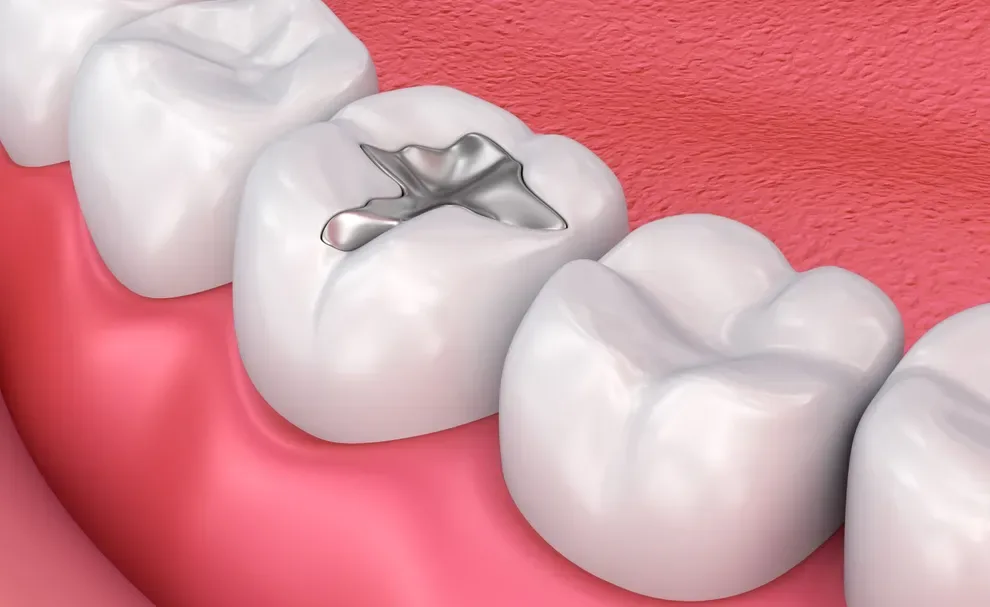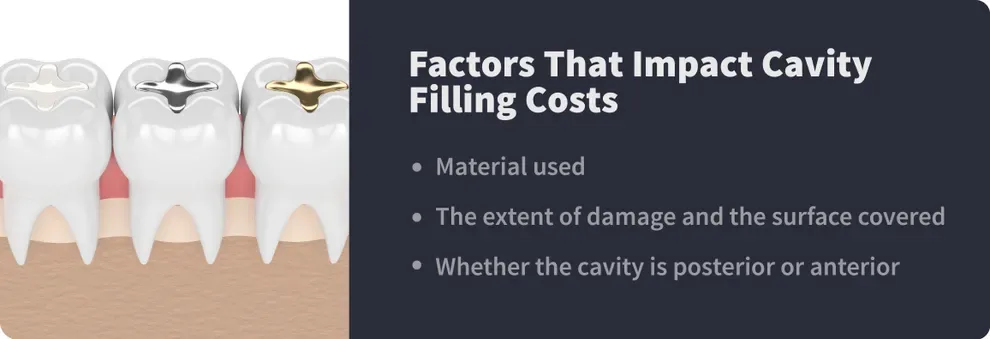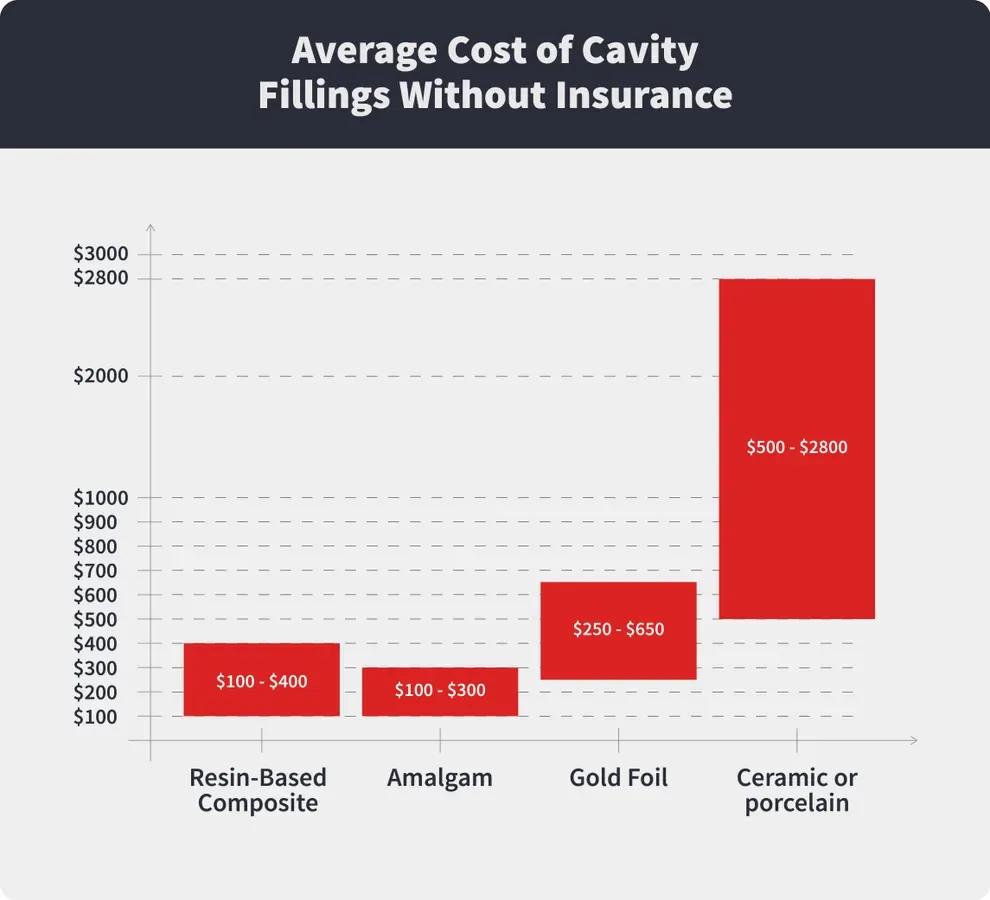Cavity Filling Costs in 2023 - With and Without Insurance

Table of Contents
- What Are Cavity Fillings
- Cavity Fillings Cost With Insurance
- Cavity Fillings Cost Without Insurance
- Cavity Fillings Cost Overview
- Help For Paying For Fillings
- References
A cavity filling will cost $150 to $1,100 per tooth in 2023, depending on the type of material used and the severity of the cavity.
According to data collected for the National Health and Nutrition Examination Survey, approximately 2.4 billion people have cavities in their teeth. While the situation has gotten better in the last few decades, there’s still much awareness needed to improve and maintain teeth hygiene and health.
Dental hygiene has come a long way. Today, you can get various kinds of cavity fillings depending on the affected area, your budget, and preference.
What Are Cavity Fillings?
Tooth decay or cavities are holes that form on the surface of the tooth. In most cases, cavities start small, then gradually enlarge, especially with poor dental hygiene and irregular dental checkups.
Cavities can be caused by various factors, including bacterial infection, frequent consumption of snacks and sugary drinks, and not cleaning the teeth properly. Since they start small, they may be initially hard to detect, especially to an untrained eye. Most people visit the dentist when the cavities are too large or develop pain.
Left untreated, cavities can lead to toothaches, infection and tooth loss.
To remedy tooth decay, dentists drill to remove any decaying material from the tooth. The dentist then fills the tooth with composite resin, porcelain fillings, gold or silver. Cavity-filling is a straightforward procedure and can be handled during one visit to the dentist.

The cost of fillings varies depending on several factors. These include:
The number of teeth being filled. The more teeth you need to be filled, the higher the cost.
The teeth that need filling. Cavity fillings in molar teeth are more expensive as these teeth are harder to reach and may require special equipment.
Size of the cavity. Large tooth decays require more work and material, significantly affecting the price.
Different conditions and underlying infections. If the gum or other teeth have been affected by the cavities, you might need more than one dental appointment.
Location and your dentist. The price of a cavity filling could also be influenced by your geographical location and the dental specialist involved.
Generally speaking, porcelain filling and composite resin are cheaper than gold and silver fillings. But you should consult with your dental healthcare provider to get the most suitable and affordable filling material.
How Much Do Cavity Fillings Cost When You Have Insurance?
Fillings aren’t considered cosmetic or elective procedures, and they are covered by most insurance service providers. Composite and amalgam fillings are usually considered a medical necessity. As such, they’re either largely or entirely covered by the insurance cover.
Check if your insurance plan covers just the filling procedure or the entire process. For instance, before the dentist fills the tooth, they need to perform an x-ray. Other additional costs may arise from plaque cleaning and removal before the procedure.
When checking the price with your dentist, ask if the insurance covers these additional costs. Also, obtain the actual cost of the whole procedure, not just for the filling repair.
A cavity can spread so quickly without treatment that a root canal or tooth extraction may be needed. Confirm you know exactly what needs to be done to repair the damage and then get a quote.
How Much Do Cavity Fillings Cost Without Insurance?
The cost of dental fillings is directly tied to the material used, the extent of damage, and the surface covered. Price can also be influenced by whether the cavity is posterior or anterior.
Here’s a cost breakdown based on the material used:

The average cost of filling cavities with resin-based composite is $200 for a single surface. The price could range from $100 to $400 based on the factors outlined above.
With proper dental hygiene, regular checkups, and general maintenance, resin-based composite can last from 5 to 15 years.
On average, amalgam fillings cost $150 per single surface. The price could vary from $100 to $300 across America. Amalgam fillings are affordable and can last up to 10 years with proper care.
The average cost of gold fillings is $400 for a single tooth. The price may go as low as $250 and as high as $650. Gold foil fillings last anywhere from 15 to 30 years.
Over the recent past, gold fillings have seen a decline, as they require specialized equipment and time to get the procedure right.
The most expensive cavity-filling option, porcelain fillings cost an average of $1,150. However, you can get the procedure done for as low as $500 and as high as $2,800.
Ceramic fillings are time-consuming. They must be custom-made in a lab and fitted correctly. After the procedure, you won’t have to think of replacing them for at least 15 years.
Some of the additional costs you need to factor in when getting fillings:
Dental examinations: $50 to $200 per visit
Panoramic X-rays: $100 to $250 per set
Periapical X-rays: $25 to $50 per set
Bitewing X-rays: $25 to $50 per set
Nitrous Oxide: $40 to $150 per visit
Non-intravenous conscious sedation: $75 to $500 per visit
Anesthesia: $100 to $500 per visit
Cavity Fillings Cost Overview
| Cost | |
|---|---|
| Resin-based composite | $200 |
| Amalgam | $150 |
| Gold foil | $400 |
| Ceramic or porcelain | $1,100 |
| Factors that could increase cost | Location of cavity: Hard-to-reach molars may be harder to work on and more expensive. Size of cavity: Large cavities may take longer to fill. Other conditions affecting the tooth: Gum or decay issues may require treatment before a filling. |
| Other treatment fees that could increase cost | Exam: $50–$200 X-rays: $25–$250+ Anesthesia: $100–$500 Non-intravenous conscious sedation: $75–$500+ Nitrous oxide: $40–$150 |
Ways to Get Help for Paying for Fillings
Fillings aren’t cheap, and you should always inquire with your dentist’s office manager about what your insurance will cover. If you don’t have dental insurance, you can go through the American Dental Association and search for affordable dental services near you. Additionally, you could scout for local dentistry schools, which often offer discounts on most procedures.
It’s essential to observe proper dental hygiene and make regular dental appointments. These are the most proven ways of keeping your teeth clean and free from cavities. Dental checkups also help identify cavities early on before the damage gets too extensive.
